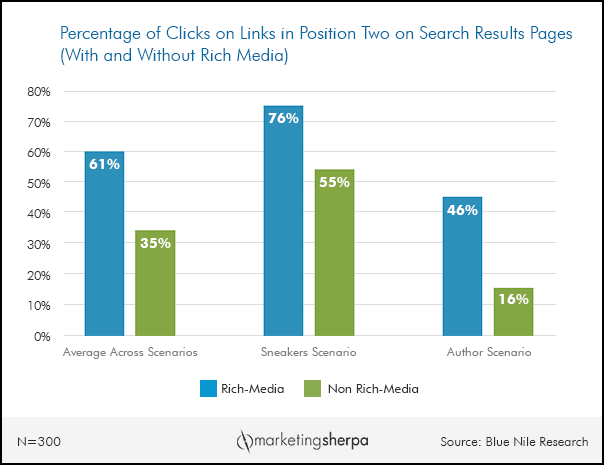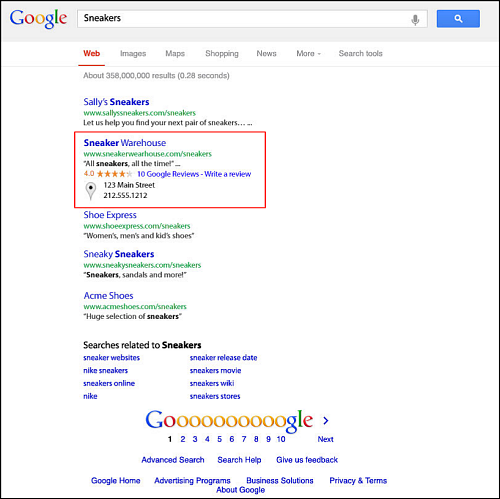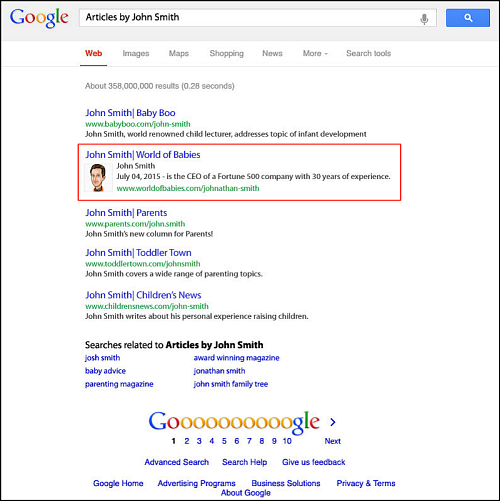by
Daniel Burstein, Director of Editorial Content, and
Dr. Liva LaMontagne , Editorial Research Manager
In a lab environment, Blue Nile Research asked 300 respondents to imagine conducting a specific type of search, and then showed them a SERP (search engine results page) for each scenario both with and without rich media.
The below chart shows the results of two of these scenarios — a search for "sneakers" and a search for "articles by John Smith."

Click here to see a printable version of this chart
What exactly did the rich media look like? The first scenario included star reviews.

Click here to see the full version of this creative sample
The second scenario featured an author image.

Click here to see the full version of this creative sample
When you look at the results from the above chart, you probably won’t be surprised that the pages with rich media had a higher clickthrough rate than the pages without rich media.
However, the difference amount is significant. For example, in the author scenario, that small image generates almost triple the amount of clicks. (Maybe this is a good case for Google to bring back Google Authorship, which it ended support for in August 2014.)
Rich media generates more clickthrough than a top rank
Every search engine optimization (SEO) professional likely has an ultimate goal in mind — perhaps the coveted top rank: the #1 position on a SERP page.
But an interesting discovery from this research is that we can all learn from Doyle Dane Bernbach’s campaign for Avis — "When you’re only No. 2, you try harder."
Yes, the search results with rich media in the #2 position got a higher clickthrough rate than the search results with rich media in the same position.
However, search results with rich media in the #2 position also outperformed the top rank:
- The star reviews listing in position #2 captured more than three-quarters (76%) of clicks, compared to a mere 9% for the unenhanced retailer in position #1
- The author image captured 46% of clicks compared to 10% captured by the result in position #1
SEO doesn’t end at the ranking; you need to get the click
The biggest lesson for me from this data is that getting a good rank for your website is not enough. Remember, the ultimate goal is to get the click.
"People recognize that if you are in the top five [of] organic [search results], then you must be a useful site," Chris N. Cheetham-West, a corporate SEO trainer, said.
As with other forms of advertising or really any place customers have a choice to make, you must have a process-level value proposition.
Rich media can certainly help, but it is not the only approach to garner clickthrough on SERPs. Here are three ideas to help you get more traffic to your website from SERPs:
Idea #1: Leverage whatever rich media you can
Long gone are the days when search results and Web browsing in general were just a text-based medium.
While Google Authorship is not (currently) an option, location, images, news, video and shopping are all examples of rich media that appear in Google’s Universal Search (the search engine’s practice of displaying many types of searches on the main Google SERP).
"As you develop a long-term plan to capture rich media opportunities in your search results pages, be sure to act on those elements you can immediately control," advised Nathan Safran, CEO and Founder, Blue Nile Research.
He added that marketers should capture reviews on their site or partner with a review vendor.
"Claim your business’s local registration with Google. Leverage markup on your site. Such actions give you the best chance of appearing in rich media in the search results page and benefit, as a result, through increased traffic on your site," he said.
Idea #2: Find other ways to provide more information about your website
"Yes, images and rich media play a role because anything that gives the searcher more info on what they are clicking on is useful," Cheetham-West said.
For that same reason, Cheetham-West recommends sitemaps, another example of providing information to customers about what they are clicking on.

Click here to see the full version of this creative sample
Idea #3: Communicate value in the text on the SERP page
The above two examples are effective because they help you take up valuable real estate on a SERP with eye-catching imagery that can draw your potential customers’ attention to your search result.
But the other reason they are helpful is because they help create a process-level value proposition — essentially the answer to the question "Why should [PROSPECT A] click this search engine result rather than any other search engine result?"
An important element of an effective value proposition is credibility. One reason I think rich media achieves more clicks in the experiments shown above is because the rich media used helps establish credibility.
Reviews from your fellow customers enable you to trust a company more. Knowing there is a real person with a face and a name behind the content subconsciously instills greater trust (the same reason researchers are testing giving robots human-like qualities).
While meta descriptions are not a ranking factor, using them to build trust through the snippets that appear on SERPS may be worth just as much of your attention as ranking factors like high-quality content if SEO is important to your business.
Related Resources
Best Practices for Improving Search and Social Marketing IntegrationSearch’s Position 1 is Not All It’s Cracked Up to Be (by Nathan Safran and Gila Allswang)
SEO: Search Engine Optimization Basics for Business Owners (by Chris N. West)
Will Google Bring Back Google Authorship? (by Mark Traphagen on Moz Blog)
Customer Value: The 4 essential levels of value propositions [From the MarketingExperiments Blog]
Value Proposition Development online course (from MECLABS Institute, MarketingSherpa’s parent research organization)
MarketingSherpa Summit 2016 — At the Bellagio in Las Vegas, February 22-24













